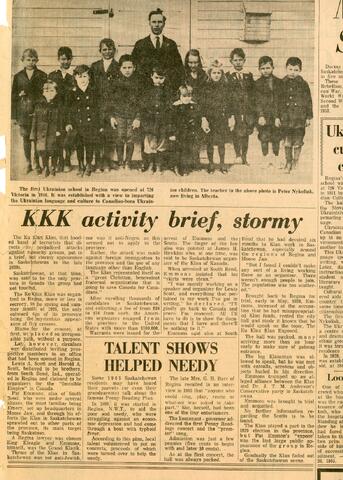
Title and statement of responsibility area
Title proper
Ku Klux Klan in Saskatchewan newspaper article
General material designation
Parallel title
KKK activity brief, stormy
Other title information
Title statements of responsibility
Title notes
Level of description
Item
Repository
Reference code
Edition area
Edition statement
Edition statement of responsibility
Class of material specific details area
Statement of scale (cartographic)
Statement of projection (cartographic)
Statement of coordinates (cartographic)
Statement of scale (architectural)
Issuing jurisdiction and denomination (philatelic)
Dates of creation area
Date(s)
Physical description area
Physical description
0.1 cm textual record
Publisher's series area
Title proper of publisher's series
Parallel titles of publisher's series
Other title information of publisher's series
Statement of responsibility relating to publisher's series
Numbering within publisher's series
Note on publisher's series
Archival description area
Name of creator
Administrative history
The newspaper was first published as The Leader in 1883 by Nicholas Flood Davin, soon after Edgar Dewdney, Lieutenant-Governor of the North-West Territories, decided to name the vacant and featureless site of Pile-O-Bones, renamed Regina by Princess Louise, Duchess of Argyll, the wife of the Governor General of Canada, as territorial capital, rather than the previously-established Battleford, Troy and Fort Qu'Appelle, presumably because he had acquired ample land on the site for resale.
The first Leader Building, Regina, Assiniboia, 1884
"A group of prominent citizens approached lawyer Nicholas Flood Davin soon after his arrival in Regina and urged him to set up a newspaper. Davin accepted their offer – and their $5000 in seed money. The Regina Leader printed its first edition on March 1, 1883."[2] Published weekly by the mercurial Davin, it almost immediately achieved national prominence during the North-West Rebellion and the subsequent trial of Louis Riel. Davin had immediate access to the developing story, and his scoops were picked up by the national press and briefly brought the Leader to national prominence.
Davin's greatest coup was sending his reporter Mary McFadyen Maclean to conduct a jailhouse interview with Riel. Maclean obtained this by masquerading as a francophone Catholic cleric and interviewing Riel in French under the nose of uncomprehending anglophone watch-house guards.
Custodial history
Scope and content
Newspaper article about the history of the Ku Klux Klan in Saskatchewan in 1926-1928
Notes area
Physical condition
Immediate source of acquisition
Arrangement
Language of material
Script of material
Location of originals
B24
Availability of other formats
Restrictions on access
Terms governing use, reproduction, and publication
Finding aids
Associated materials
Accruals
General note
According to the article, three American recruiters from South Bend, Indiana, enrolled thousands of candidates in Saskatchewan and then absconded with over $100,000. One of them, Pat Emmons, was brought back for trial but was acquitted. "Gradually the Klan faded out of the Saskatchewan scene"
There were organizational activities by the Klan in Indian Head.
Alternative identifier(s)
Standard number area
Standard number
Access points
Subject access points
Place access points
Name access points
- Saskatchewan Ku Klux Klan (Subject)
- Emmons, Pat (Subject)

